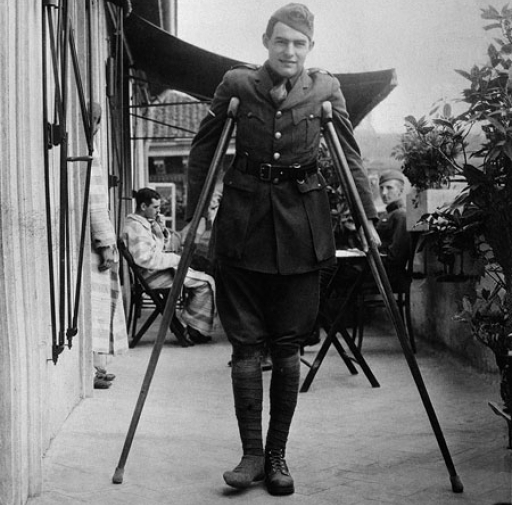ALL-TIME AMERICAN WRITERS TOURNAMENT

Time to give the answer to our Hemingway-Fitzgerald Trivia Question! We asked,
“In what two F. Scott Fitzgerald pop stories was a major character a thinly-disguised version of Ernest Hemingway?”
AFTER WE SENT the question to an array of literary experts, we received responses from two of them reminding us of F. Scott Fitzgerald’s “Philippe” stories published in Redbook magazine in 1934/35. The chief character Philippe is based on Fitzgerald’s intermittent hero worship of the younger writer. We haven’t read the stories, and don’t know if they’ve been anthologized. Thanks to Dr. Kirk Curnutt and Dr. Scott Donaldson for the information. (They can collect on our original prize of a free beer in Detroit at any time.)
*******
But while the Philippe answer is technically correct, we were thinking of two other, better known Scott Fitzgerald stories.
The first is “A Snobbish Story,” originally published in the Saturday Evening Post in November of 1930, then later by Scribner’s in a collection, The Basil and Josephine Stories. It’s an excellent story, with dialogue which still bites, between rich girl Josephine and a young Chicago journalist. The characterization of the journalist is superb– there are more than enough clues in it to determine this is a vivid portrayal of the young Ernest Hemingway.
“–his eyes were nearly black, with an intense, passionate light in them; his mouth was sensitive and strongly set.”
The character, John, is described as a large young man. John talks and behaves much like how the early Hemingway must’ve been. Brash, confident, outspoken; “extraordinarily handsome.” “I’m going to be a great writer someday,” he announces.
Josephine and the young man insult each other. She tells him, “I’m going into a convent or else to be a trained nurse in the war.” (The story is set in 1916, when the Great War was raging in Europe.) “Will you enlist in the French army and let me nurse you?”
This is not just a nod to Hemingway, who was famously nursed by a beautiful nurse in that war– it’s an obvious one, given that Hem’s A Farewell to Arms had been published a year before Scott wrote this story, and was still topping best-seller lists. The plot concerns an injured young man who falls in love with his nurse.
“I want to be the best writer in the world, that’s all,” the John character says. In 1930, Ernest Hemingway was in the process of becoming exactly that.
The clincher in deciding that the character is based on young Ernest Hemingway comes when the man’s wife shows up! “–a handsome girl–.” “Neither of us believed in the old-fashioned bourgeois marriage–” John tells Josephine, about his wife.
Ernest Hemingway had something of an open marriage with his first wife– at least after future second wife Pauline showed up!
*******
It’s not as if F. Scott Fitzgerald was NOT known for putting persons he knew into his fiction. He in fact did this time and again– most notably with his wife Zelda, but also with good friends the Murphys; with old college friends; with old girlfriends; with anyone and everyone. Hemingway was a large presence in Scott Fitzgerald’s life; first as protege; then, equal. In subtle ways, as rival.
*******
The second story completing the answer to our Trivia Question is “Financing Finnegan,” originally published in Esquire magazine in January 1938.
The timing and venue of this publication are telling. In 1936 Ernest Hemingway published, in Esquire, “The Snows of Kilimanjaro,” in which he mentioned F. Scott Fitzgerald by name in a disdainful way. Fitzgerald was highly embarrassed, to the extent of asking Ernest to change the name in any future appearances of the story. Hemingway complied. Was it payback time?
The character “Finnegan” is described by the narrator but never seen. The relationship between the two writers mimics that of Fitzgerald and Hemingway. They both have the same publisher. Finnegan receives the kind of large advances for his work that the narrator used to receive. Finnegan is working on a novel, “one of those great successful novels of his.” “There’s never been such a talent,” the narrator says, a bit sarcastically. “His was indeed a name with ingots in it.”
Finnegan is injury prone– as Hemingway famously was– and is also a world traveler, forever looking for new experiences, new material for his work. (He’s said to be at the North Pole, then in Norway.) The clincher comes when the narrator describes Finnegan’s work.
The writing is described as containing “–a shy frankness together with an impression of a very quiet brave battle going on inside of him that he couldn’t quite bring himself to talk about– but that showed as heat lightning in his work.”
Does that not describe the writing of Ernest Hemingway?
“–nobody ever denied that Finnegan could write.”
The story catches Finnegan between successes, when he’s straining the faith of his publisher. Everyone hopes he’ll come through with a “great, successful novel.” In the real world Ernest Hemingway would do this, when For Whom the Bell Tolls was released in 1940.
Overall the story is derogatory toward Finnegan. It strongly hints at Fitzgerald’s disillusionment with Hemingway, particularly when the narrator says, “I’ve taken it upon myself to investigate some of the stories about him–.” And found they were mostly fake.
*******
Hemingway was to have the last word in his memoir of the 1920’s, A Moveable Feast.

 *******
*******
 ***
***


 (Joyce Carol Oates.)
(Joyce Carol Oates.)












